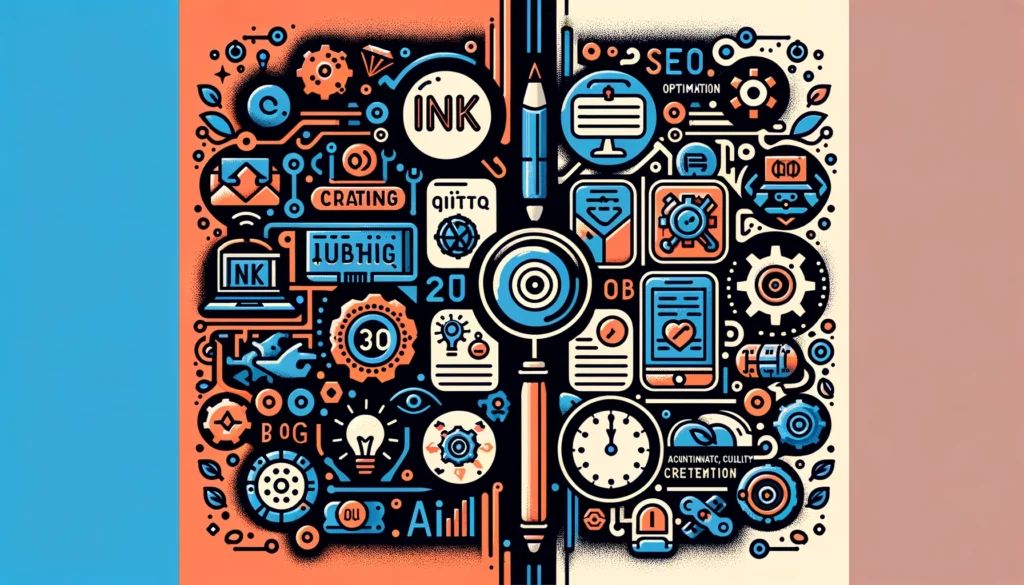Gpt4 By Openai Alternatives
Looking for alternatives to GPT-4 by OpenAI?
This article discusses why alternatives to GPT-4 are needed and explores popular options like Autoblogging.ai, Copy.ai, Article Forge, Writesonic, and Rytr.
Autoblogging.ai is highlighted as the best choice for its superior SEO optimization and ranking ability.
The article also examines the main differences between GPT-4 and its alternatives, offering a step-by-step guide on how to use Autoblogging.ai for article generation.
Keep reading to learn more!
Contents
Key Takeaways:
- GPT-4 by OpenAI has been a popular choice for article generation, but its alternatives are gaining attention.
- Alternatives like Autoblogging.ai offer SEO optimization, ranking ability, ease of use, and cost-effectiveness.
- To use Autoblogging.ai, simply set up an account, choose a topic and input keywords, customize output preferences, and review and edit the generated article.
What is GPT-4 by OpenAI?
GPT-4, developed by OpenAI, is an advanced artificial intelligence model that belongs to the realm of cutting-edge language models.
With its impressive capacity to understand and generate human-like text, GPT-4 has substantially pushed the boundaries of AI technology.
It boasts enhanced capabilities in natural language processing, enabling it to engage in more sophisticated conversations and generate coherent and contextually relevant responses.
This model has been fine-tuned using extensive datasets and advanced algorithms, allowing it to demonstrate remarkable improvements in language comprehension and generation.
The development of GPT-4 marks a significant milestone in the field of artificial intelligence, showcasing the tremendous progress that has been made in creating AI systems that can mimic human-like language abilities.
Why are Alternatives to GPT-4 by OpenAI Needed?
The necessity for alternatives to GPT-4 by OpenAI arises from the evolving demands for diverse AI models and language processing solutions in various industries.
These growing needs stem from the need for AI models to cater to specialized industries like healthcare, finance, and legal services, which require more nuanced and domain-specific language understanding.
Language models must now possess not just accuracy but also the ability to handle complex contextual dependencies, ethical considerations, and a wider range of languages and cultural nuances.
The limitations of GPT-4 in terms of bias, explainability, and adaptability in dynamic scenarios have prompted the search for more versatile alternatives that can prioritize fairness, transparency, and adaptivity.
What are the Alternatives to GPT-4 by OpenAI?
Several alternatives to GPT-4 by OpenAI include Autoblogging.ai, Copy.ai, Article Forge, Writesonic, and Rytr, each offering unique features and capabilities in the AI and language model spectrum.
Autoblogging.ai stands out for its automated content generation for blogs and websites, making it an ideal tool for marketers and businesses looking to streamline their content creation process.
Copy.ai focuses on helping users generate high-quality written content, including ads, product descriptions, and social media posts efficiently.
- Article Forge specializes in creating unique articles on any given topic, leveraging AI to produce well-researched and coherent content in a fraction of the time it would take a human writer.
- Writesonic is known for its advanced copywriting capabilities, enabling users to craft engaging copy for marketing materials, emails, and more.
- Rytr distinguishes itself with its focus on assisting users in writing in different tones and styles, catering to a wide range of content needs from formal business communication to creative storytelling.
Each of these alternatives plays a crucial role in the AI landscape and offers distinctive functionalities for various language processing tasks.
Autoblogging.ai
Autoblogging.ai stands out as a prominent alternative to GPT-4 by OpenAI, excelling in SEO optimization and ranking capabilities through its advanced AI technology.
One of the key features that sets Autoblogging.ai apart is its AI-powered SEO optimization , which allows users to automatically generate high-quality content optimized for search engines, helping websites climb up the search rankings.
In addition, its robust AI technology ensures that every post is tailored to target specific keywords, increasing visibility and driving organic traffic.
By seamlessly integrating with LLMOps, Autoblogging.ai streamlines operations, enhances performance, and optimizes content distribution, making it a versatile and powerful tool for content creators and digital marketers alike.
Copy.ai
Copy.ai emerges as a noteworthy alternative to GPT-4 by OpenAI, showcasing advancements in AI technology and leveraging models like GPT-5 and Claude 2 to enhance content generation.
One of the key features that set Copy.ai apart is its seamless integration of advanced AI models like GPT-5 and Claude 2, allowing users to effortlessly generate high-quality content with minimal effort.
The utilization of these cutting-edge technologies enables Copy.ai to produce content that is not only accurate but also tailored to specific requirements.
The impact of these advancements can be seen in the rapid pace at which content can be generated, revolutionizing the way businesses approach content creation and significantly reducing the time and resources required for the process.
Article Forge
Article Forge presents itself as a compelling alternative to GPT-4 by OpenAI, emphasizing content creation powered by large language models such as Vicuna 1.3 for efficient output generation.
Article Forge sets itself apart by harnessing the capabilities of Vicuna 1.3, which allows for the creation of high-quality content at scale.
This tool excels in generating articles, blog posts, and even product descriptions with remarkable efficiency.
One of the standout features of Article Forge is its ability to integrate relevant keywords and entities seamlessly into the generated content, ensuring that the output is not only well-written but also contextually rich.
By utilizing advanced algorithms and natural language processing, Article Forge streamlines the content creation process, making it an invaluable tool for businesses, marketers, and writers seeking to enhance their online presence and engagement.
Writesonic
Writesonic emerges as a user-friendly alternative to GPT-4 by OpenAI, incorporating conversational AI elements from Anthropic to streamline content creation processes.
With Writesonic, users can effortlessly navigate through its intuitive interface, making the software accessible to both experienced content creators and beginners alike.
By seamlessly integrating Anthropic’s conversational AI components, Writesonic is equipped with the ability to understand and interpret user input in a human-like manner.
This enables users to generate high-quality content with ease, as the AI assists in structuring and optimizing the text for better engagement.
The inclusion of keywords and entities for context in Writesonic’s algorithms ensures that the generated content is not only well-written but also tailored to specific needs.
This feature greatly enhances the overall efficiency of the content generation process, allowing users to focus more on creativity and strategy rather than mundane tasks.
Rytr
Rytr offers a cost-effective alternative to GPT-4 by OpenAI, leveraging a chatbot UI that facilitates interactive conversations for efficient content creation.
With Rytr’s innovative chatbot UI, users can easily engage in interactive conversations to tailor content according to their specific needs and requirements, resulting in a more personalized output.
This approach not only improves the user experience but also saves time and resources by streamlining the content creation process.
By utilizing Rytr’s interactive conversation capabilities, businesses and individuals can generate compelling content efficiently without the need for extensive manual input or editing, making it a valuable tool for cost-efficient content generation.
What are the Main Differences between GPT-4 and its Alternatives?
The distinctions between GPT-4 and its alternatives span areas such as training data sources, language model variations, output quality levels, and SEO optimization approaches.
One key difference lies in the training data sources utilized by GPT-4 and its counterparts.
While some models rely on specific datasets, GPT-4 benefits from a more diverse range of sources, leading to a broader understanding of language nuances and context.
In terms of language model variations, GPT-4 boasts enhanced capabilities in generating contextually relevant responses compared to earlier versions.
This advancement results in more coherent and structured outputs, making interactions with the model more seamless for users.
Output quality comparisons between GPT-4 and other models highlight the superior coherence and relevance of responses produced by GPT-4.
Its unique algorithms contribute to generating more human-like text, enhancing the overall user experience.
In terms of SEO optimization strategies, GPT-4 provides enhanced tools and features to improve content visibility and ranking on search engines.
Its ability to generate engaging and informative content aligns well with SEO best practices, making it a valuable asset for digital marketers and content creators.
Training Data
Training data for GPT-4 and its alternatives vary in sources and methodologies, with models like LMQL allowing for supervised instruction fine-tuning to enhance performance.
In terms of training GPT-4 and similar models, the quality and diversity of the input data are paramount.
The data sets used can range from curated text corpora to real-world conversational exchanges, each offering its own set of challenges and advantages.
For instance, leveraging large-scale corpora can lead to more generalized language understanding, while fine-tuning through LMQL enables tailored adjustments for specific tasks or domains.
Therefore, the selection of training data and the methodologies employed, such as LMQL, play a crucial role in shaping the capabilities and performance of language models.
The meticulous curation and annotation of LMQL data contribute to the refined tuning process, ultimately resulting in more accurate predictions and responses from the model.
Language Models
Language models such as GPT-4 and its alternatives like GPT-5 and Claude 1.3 showcase varying capabilities in natural language generation and text processing tasks.
When comparing GPT-4 with newer models like GPT-5 and Claude 1.3, one can observe significant advancements in the way these models handle complex language structures and nuances.
GPT-4 laid a strong foundation in natural language processing, but its successors have built upon this groundwork, enhancing efficiency and the ability to generate more coherent and contextually relevant text.
The evolution from GPT-4 to models like GPT-5 and Claude 1.3 signifies a trend towards more sophisticated language understanding and improved text generation capabilities.
Output Quality
Output quality metrics differ between GPT-4 and its alternatives, with models like Claude 2 showcasing superior performance benchmarks akin to passing a Bar Exam.
When analyzing the capabilities of GPT-4, one can observe its remarkable ability to generate coherent, contextually relevant content, but it may fall short in terms of fine-tuned accuracy and nuanced understanding compared to specialized models.
Conversely, entities such as Claude 2 leverage cutting-edge architecture and training data, enabling them to excel in tasks requiring intricate logic and domain-specific knowledge.
This evolution has led to a noticeable enhancement in the fluency, coherence, and accuracy of content created by advanced models like Claude 2, setting new standards for AI-generated content that some consider on par with human-generated copywriting.
SEO Optimization
SEO optimization strategies employed by GPT-4 and alternatives like Autoblogging.ai differ, integrating technologies such as Google AI and PaLM 2 to enhance search engine ranking capabilities.
Google AI, renowned for its exceptional natural language processing capabilities, plays a pivotal role in deciphering search intent and improving content relevance. PaLM 2, on the other hand, focuses on enhancing language understanding and user interaction, thus bolstering the overall user experience.
These advanced technologies enable GPT-4 to delve deeper into semantic analysis, ensuring that keywords and entities are seamlessly integrated for enhanced contextual understanding.
By leveraging these cutting-edge tools, GPT-4 paves the way for more effective SEO strategies, ultimately driving improved search engine visibility.
Why is Autoblogging.ai the Best Alternative to GPT-4 by OpenAI?
Autoblogging.ai emerges as the premier alternative to GPT-4 by OpenAI due to its unparalleled SEO optimization capabilities and exceptional ranking prowess.
What sets Autoblogging.ai apart is its sophisticated understanding of search engine algorithms and user intent, allowing it to craft content that not only ranks high but also resonates with the audience organically.
This platform utilizes advanced machine learning models to predict trends, keywords, and topics that are most likely to drive traffic and engagement.
Unlike GPT-4, Autoblogging.ai constantly evolves its algorithms to keep pace with the ever-changing world of SEO, ensuring that its users stay ahead of the competition.
SEO Optimization
Autoblogging.ai‘s supremacy lies in its advanced SEO optimization techniques, leveraging large language models and technologies like Google AI to enhance search engine visibility.
By utilizing the strength of large language models, Autoblogging.ai can automatically generate high-quality content embedded with relevant:
- keywords
- entities
optimizing it for search engines. The incorporation of Google AI further refines its content creation by fine-tuning it to match user search queries and preferences, thereby improving its organic reach.
This seamless integration not only boosts the overall SEO performance but also ensures that the generated content aligns with the latest trends and search engine algorithms, consolidating the platform’s position as a leader in automated content creation and optimization.
Ranking Ability
Autoblogging.ai’s exceptional ranking ability sets it apart as the ideal alternative to GPT-4, showcasing prowess in search engine rankings through its integrated SEO optimization and LLMOps support.
By leveraging advanced algorithms and machine learning, Autoblogging.ai streamlines the process of content creation and distribution, ensuring that every piece of published content is optimized for search engines.
SEO optimization plays a crucial role in enhancing visibility and driving organic traffic to websites, allowing Autoblogging.ai users to gain a competitive edge in the digital landscape.
The incorporation of LLMOps further bolsters performance by fine-tuning content delivery, analyzing user intent, and seamlessly integrating relevant keywords and entities for contextual relevance.
Ease of Use
Autoblogging.ai’s user-friendly interface and integration of conversational AI elements from Anthropic contribute to its unmatched ease of use, making it a preferred choice over GPT-4.
Through its sleek and intuitive design, Autoblogging.ai simplifies the content creation process, allowing users to seamlessly navigate and manage their automated blogging tasks.
The incorporation of Anthropic’s conversational AI technology elevates the platform by enabling natural interactions and personalized assistance, enhancing the overall user experience.
With Autoblogging.ai, individuals can effortlessly generate engaging blog posts and articles without the need for extensive manual input or technical expertise.
The intuitive workflow and AI-driven guidance provided by Anthropic’s technology give the power to users to create high-quality content efficiently and effectively.
Cost-effectiveness
Autoblogging.ai’s cost-effectiveness, coupled with its API integration and collaboration with platforms like ShareGPT.com, positions it as the most economical alternative to GPT-4.
Autoblogging.ai stands out for being a cost-effective solution and for its seamless API functionalities, which allow users to streamline their processes efficiently.
By leveraging the power of automation and collaboration with ShareGPT.com, users can access a comprehensive suite of tools tailored to their needs.
This strategic partnership enhances the accessibility and versatility of Autoblogging.ai, ensuring that users can generate high-quality content effortlessly.
How to Use Autoblogging.ai for Article Generation?
Utilizing Autoblogging.ai for article generation entails setting up an account, selecting relevant keywords, customizing output preferences, and refining the generated content for optimal results.
Once you have created an account on Autoblogging.ai, the next step is to delve into the keyword selection process.
This is a crucial phase as it determines the direction and focus of the generated content. Choose keywords that are not only relevant to your niche but also have a strong search volume for better visibility.
After setting up your keywords, it’s time to customize the output preferences. Tailor the settings according to your desired tone, style, and word count.
These adjustments help in aligning the generated content with your brand’s voice and requirements.
When the content is generated, make sure to review it thoroughly.
Look for opportunities to integrate important keywords and relevant entities to enhance context and clarity.
Editing plays a vital role in refining the generated content to meet your expectations and resonate with your audience.
Set Up Account and Select Plan
To begin using Autoblogging.ai, users need to set up an account, choose a suitable subscription plan, and operationalize the platform for efficient article generation.
After creating an account on Autoblogging.ai, users are presented with a range of subscription plan options to select from based on their needs and requirements.
These plans typically offer various features and benefits, such as access to advanced AI algorithms and increased article output capacity.
Once the subscription plan is chosen, users are guided through the process of operationalizing the platform, which involves setting up preferences, defining key parameters, and incorporating relevant keywords and entities for context and relevance in the generated articles.
This ensures that the AI-driven content creation aligns with the user’s goals and intended audience.
Choose Topic and Input Keywords
Selecting a topic and inputting relevant keywords into Autoblogging.ai lay the foundation for content generation, ensuring alignment with chosen datasets and thematic requirements.
Proper keyword selection is vital for Autoblogging.ai’s algorithm to understand the context and relevance of the input.
By incorporating carefully chosen keywords, users can significantly impact the generated content quality.
Through dataset alignment, Autoblogging.ai utilizes the thematic relevance of the selected topic to produce coherent and engaging posts.
This alignment ensures that the AI-powered platform leverages the available data to offer content aligned with the user’s specific requirements.
Incorporating keywords and entities that reflect the topic enhances the overall context and strengthens the SEO value of the generated posts.
Customize Output Preferences
Tailoring output preferences within Autoblogging.ai allows users to customize content styles, formats, and tones through the platform’s intuitive interface and chatbot UI functionalities.
Users can easily navigate through the chatbot UI to select preferred writing tones, such as informal, formal, or professional, ensuring that the generated content aligns with their branding or communication goals.
The platform offers a diverse range of content formats, including articles, blog posts, and social media updates, catering to different publishing needs.
Users can seamlessly integrate keywords and entities to provide context and relevance to the AI-generated content, optimizing it for search engines and audience engagement.
Review and Edit Generated Article
Finalizing the article generation process with Autoblogging.ai involves reviewing and editing the generated content to ensure accuracy, coherence, and alignment with quality standards.
After the content is generated by Autoblogging.ai, it is crucial to conduct a thorough review to catch any discrepancies or inconsistencies.
Pay close attention to the flow of information and the overall structure of the article to ensure it makes sense to the readers.
Utilize tools for grammar and spell checks, and also manually go through the content to refine the language and style. Quality assurance plays a vital role in upholding the credibility of the content.
One key aspect to focus on during the editing process is to integrate relevant keywords and entities seamlessly throughout the article.
This helps in providing context and improving the SEO performance of the content.
Ensure that the tone and voice of the article align with the target audience and the overall messaging of your platform.
Conclusion
In conclusion, Autoblogging.ai proves to be a game-changing alternative to GPT-4 by OpenAI, revolutionizing the landscape of article generation with its advanced capabilities and user-centric approach.
Autoblogging.ai offers users a seamless, efficient solution for automated content creation, employing cutting-edge artificial intelligence technology.
Its robust platform harnesses natural language processing algorithms to swiftly generate high-quality articles, streamlining the time-consuming process for content creators.
This innovative software is designed to cater to various industries, from blogging to e-commerce, ensuring tailored outputs that align with each user’s preferences and requirements.
By integrating Autoblogging.ai into their workflows, individuals and businesses can significantly enhance productivity and scale their content creation operations.
Frequently Asked Questions
1. What is GPT-4 by OpenAI Alternatives?
GPT-4 by OpenAI Alternatives refers to the various alternatives to the GPT-4 language model developed by OpenAI. These alternatives use similar AI technology to generate human-like text and have been gaining popularity in the market.
2. What are the top alternatives to GPT-4 by OpenAI?
Some of the top alternatives to GPT-4 by OpenAI include Autoblogging.ai, Copy.ai, Article Forge, Writesonic, and Rytr.
These AI-powered tools offer similar features to GPT-4 and are known for generating high-quality content.
3. Why is Autoblogging.ai considered the best alternative to GPT-4 by OpenAI?
Autoblogging.ai has gained recognition as the best alternative to GPT-4 by OpenAI due to its highly SEO-optimized and easily rankable articles.
This tool uses advanced AI technology to generate unique and relevant content that can boost your website’s search engine rankings.
4. How does Copy.ai compare to GPT-4 by OpenAI?
Copy.ai is another alternative to GPT-4 that uses AI to generate human-like text.
While it may not have the same level of sophistication as GPT-4, Copy.ai is known for its user-friendly interface and fast content generation capabilities.
5. Is Article Forge a reliable alternative to GPT-4 by OpenAI?
Yes, Article Forge is a highly reliable alternative to GPT-4 by OpenAI.
This tool uses advanced AI algorithms to generate high-quality articles in a matter of seconds.
It is also known for its ability to generate content in multiple languages.
6. Can I use Rytr as a substitute for GPT-4 by OpenAI?
While Rytr is a popular AI-powered writing tool, it may not be a complete substitute for GPT-4 by OpenAI.
While GPT-4 is specifically designed for text generation, Rytr offers a wider range of writing features such as summarization, rephrasing, and translation.
Related SAAS Posts
Check out all the ‘software as a service’ posts from the Growth Giants team:
- Advertising for SAAS

- Agilitywriter Alternatives

- Aiwriter Review

- Chatgpt Review

- Chatgpt Vs Autoblogging.ai

- Closerscopy Alternatives

- Closerscopy Review

- Copyai Review

- Copysmith Alternatives

- Copysmith Vs Autoblogging.ai

- Cuppa.sh Vs Autoblogging.ai

- Email Marketing for SAAS

- Frase Vs Autoblogging.ai

- Getgenie Vs Autoblogging.ai

- Gpt4 By Openai Alternatives

- Gpt4 By Openai Vs Autoblogging.ai

- Grammarly Alternatives

- Grammarly Vs Autoblogging.ai

- Growthbar Review

- Growthbar Vs Autoblogging.ai

- Hemingway Editor Vs Autoblogging.ai

- Hoppycopy Alternatives

- Hoppycopy Review

- Hoppycopy Vs Autoblogging.ai

- Hubspot Alternatives

- Hubspot Vs Autoblogging.ai

- Hypotenuse Ai Alternatives

- Ink Review

- Ink Vs Autoblogging.ai

- Jasper Review

- Jasper Vs Autoblogging.ai

- Link Building for SAAS

- Longform Ai Review

- Longshot Alternatives

- Longshot Review

- Longshot Vs Autoblogging.ai

- Marketmuse Alternatives

- Neural Text Review

- Neural Text Vs Autoblogging.ai

- Outranking Alternatives

- Outranking Vs Autoblogging.ai

- PPC for SAAS

- Prowritingaid Review

- Prowritingaid Vs Autoblogging.ai

- Quillbot Alternatives

- Quillbot Review

- Quillbot Vs Autoblogging.ai

- Reword Alternatives

- Reword Review

- Reword Vs Autoblogging.ai

- SAAS Lead Generation

- Scalenut Vs Autoblogging.ai

- SEO Consultancy For SAAS

- SEO For SAAS Companies

- Seo.ai Vs Autoblogging.ai

- Seoai Alternatives

- Seoai Review

- Seomator Review

- Seomator Vs Autoblogging.ai

- Seowriting Alternatives

- Seowriting Review

- Social Media Marketing for SAAS

- Stealth Writer Ai Vs Autoblogging.ai

- Sudowrite Vs Autoblogging.ai

- Surfer Ai Review

- Surfer Ai Vs Autoblogging.ai

- Textbuilder Ai Alternatives

- Textbuilder Ai Vs Autoblogging.ai

- Video Marketing for SAAS

- Web Design for SAAS

- Wordtune Alternatives

- Wordtune Review

- Wordtune Vs Autoblogging.ai

- Writer Vs Autoblogging.ai

- Writesonic Alternatives

- Writesonic Vs Autoblogging.ai

- Zimmwriter Alternatives

- Zimmwriter Vs Autoblogging.ai
